Saint Bernard Dog Beds
Saint Bernard’s Like Memory Foam Beds!
Introduction
Saint Bernard dog beds takes into account their health condition, sleeping style, and preferences. A memory foam bed is the best choice for health reasons.
Saint Bernard’s are one of the most recognizable and beloved dog breeds, known for their massive size, gentle temperament, and history as heroic rescue dogs in the Swiss Alps.
Originally bred by monks at the Great St. Bernard Hospice, these dogs were used to locate and rescue travelers lost in the snow-covered mountains. Their incredible sense of smell, strength, and endurance made them the ideal breed for this challenging work.
Today, Saint Bernard’s are primarily known as family pets, admired for their affectionate and loyal nature. Despite their imposing size, they are often referred to as “gentle giants” because of their calm and friendly demeanor, especially around children.
However, owning a Saint Bernard comes with unique challenges and responsibilities. Due to their large size, they require ample space and a balanced diet to support their growth and health. Their thick coats make them more suited to cooler climates, and they are prone to overheating in warmer weather.
In addition, Saint Bernard’s are prone to certain health issues, such as hip dysplasia and bloat, which potential owners must be aware of. Despite these challenges, Saint Bernard’s make wonderful companions for those who can accommodate their needs, offering loyalty, love, and a history of bravery that is unmatched by most breeds.
In this guide we share information about the Saint Bernard so potential new owners to learn about if they want this dog as a pet.
The topics include best bed types, brands, facts, fun facts, health conditions, behavior concerns, tips for new owners, costs of ownership, and safe foods and foods to avoid feeding Saint Bernard’s.
Video: Pros & Cons of A Saint Bernard Dog
This is a good video for new owners to view, prior to purchasing, to determine if they want one as a family pet.
Best Dog Bed Types
Here’s a list of the best dog bed types for Saint Bernard’s, considering their large size, weight, and need for comfort and joint support:
- Orthopedic Dog Beds
- Best for Joint Support: Saint Bernard’s are prone to hip dysplasia and arthritis, so an orthopedic bed with memory foam provides excellent support for their joints and muscles. Look for beds with thick, high-density foam to accommodate their weight.
- CertiPUR-US Seal: When shopping for a memory foam dog bed be sure to look for the CertiPUR-US seal. The seal means that the materials used do not contain toxins and chemicals that are harmful to pets and humans.
- Elevated Dog Beds
- Great for Cooling and Durability: Elevated or raised beds keep your dog off the floor, promoting air circulation and helping with temperature regulation. This is especially useful for Saint Bernard’s, as they can overheat easily. Elevated beds are also easy to clean and durable for heavy dogs.
- Bolster Dog Beds
- Comfort with Added Security: Saint Bernard’s may enjoy the security of a bolster bed with raised edges that allow them to rest their head while sleeping. The bolsters also provide extra support, especially for dogs who like to curl up.
- Waterproof Dog Beds
- Easy to Clean: Saint Bernard’s drool a lot and can track dirt into the house, so a waterproof bed with a removable, washable cover is ideal. These beds are also great for dogs prone to incontinence issues as they age.
- Pillow or Cushion Beds
- Simple and Spacious: Large pillow or cushion-style beds provide plenty of space for Saint Bernard’s to stretch out. These beds are often filled with high-loft materials, offering comfort while being lightweight and easy to move.
- Cooling Gel Beds
- For Temperature Regulation: Saint Bernard’s can overheat in warm weather, so cooling gel beds help keep their body temperature regulated. These beds are designed with cooling technology to keep your dog comfortable during hot days.
- Memory Foam Mattresses
- Support and Comfort: High-quality memory foam mattresses offer both comfort and support for large breeds like Saint Bernard’s. These beds mold to your dog’s body, reducing pressure points and improving overall rest quality.
When choosing a bed for a Saint Bernard, prioritize durability, comfort, and support for their large size and specific needs.
Best Dog Bed Brands
Here’s a list of highly recommended dog bed brands that offer quality beds for large breeds like Saint Bernard’s:
- Big Barker
- Best for Orthopedic Support: Specifically designed for large and giant breeds, Big Barker beds feature high-density memory foam that maintains its shape and provides superior joint support. These beds are perfect for Saint Bernard’s prone to joint issues like hip dysplasia and arthritis.
- Recommended Bed: Big Barker 7″ Pillow Top Orthopedic Dog Bed.
- PetFusion
- Durable and Comfortable: PetFusion offers orthopedic memory foam beds that are both comfortable and durable. Their beds also come with water-resistant covers, making them easy to clean and maintain.
- Recommended Bed: PetFusion Ultimate Dog Bed.
- K&H Pet Products
- Versatile and Affordable: K&H Pet Products offer a variety of dog bed styles, including elevated and cooling beds that work well for large breeds. Their beds are durable, breathable, and great for temperature regulation.
- Recommended Bed: K&H Original Pet Cot.
- Furhaven
- Budget-Friendly Comfort: Furhaven offers affordable orthopedic beds with various styles, including bolsters and mattress-style beds. They use egg-crate foam and memory foam, providing ample support for large dogs.
- Recommended Bed: Furhaven Orthopedic Ultra Plush Lounger.
- The Dog’s Bed
- Orthopedic Beds for Large Breeds: This brand focuses on orthopedic beds with memory foam, ideal for Saint Bernard’s’ large size and joint needs. Their beds are also waterproof and easy to clean.
- Recommended Bed: The Dog’s Bed Orthopedic Memory Foam Bed.
- Kuranda
- Best for Durability and Cooling: Kuranda is known for their elevated dog beds, which are perfect for keeping large dogs cool and comfortable. Their beds are durable and chew-resistant, making them great for Saint Bernard’s.
- Recommended Bed: Kuranda Elevated Dog Bed.
- BarksBar
- Affordable Orthopedic Option: BarksBar offers quality orthopedic beds at a lower price point, making them an excellent option for new Saint Bernard owners on a budget. These beds are made with supportive foam and have a comfortable cotton-padded rim.
- Recommended Bed: BarksBar Orthopedic Dog Bed.
- Laifug
- Long-Lasting Memory Foam Beds: Laifug beds use orthopedic memory foam designed to retain its shape even under heavy weight. The beds are waterproof and have machine-washable covers.
- Recommended Bed: Laifug Orthopedic Memory Foam Dog Bed.
Each of these brands offers a range of durable, comfortable, and supportive beds, ideal for the unique needs of Saint Bernard’s.
Facts and Fun Facts about Saint Bernard’s
Measurements:
- Size: Large
- Group: Working Group
- Height Male: 28 – 30 inches
- Height Female: 26-28 inches
- Weight Male: 140 – 180 lbs.
- Weight Female: 120 – 140 lbs.
- Length Male:5 – 47 inches
- Length Female: 40 – 43.5 inches
- Fully Grown: 2 years
- Lifespan: 8 – 10 years
- Colors: Brown & White, Mahogany & White, Orange & White, Red & White, Brindle & White, Rust & White, White & Brown, White & Orange, White & Red
- Popularity: This breed is the 55th most popular in the United States according to the American Kennel Club in 2023.
- Intelligence: This breed is ranked the 65th most intelligent according to Professor Stanley Coren at the University of British Columbia.
- To Learn More: To know more about the Saint Bernard, you can go to the Saint Bernard Club of America website: Home – Saint Bernard Club of America
Facts and Fun Facts About the Saint Bernard
Facts About Saint Bernard Dogs
- Origin: Saint Bernard’s were originally bred in the Swiss and Italian Alps by monks at the Great St. Bernard Hospice to rescue travelers lost in snowstorms.
- Size: They are one of the largest dog breeds, with males standing 28 to 30 inches tall and weighing 140 to 180 pounds (females are slightly smaller).
- Temperament: Known for their gentle, calm, and patient demeanor, Saint Bernard’s are excellent with families and children.
- Lifespan: Their average lifespan is relatively short, ranging from 8 to 10 years due to their large size.
- Coat Types: Saint Bernard’s come in two coat types: smooth (short-haired) and rough (long-haired). Both are thick and dense to withstand cold climates.
- Drooling: Saint Bernard’s are notorious for drooling, especially after eating or drinking.
- Exercise Needs: They require moderate exercise but are not high-energy dogs. Daily walks and some playtime will suffice.
- Grooming: They shed year-round and require regular brushing to prevent matting, especially with the rough coat variety.
- Training: Saint Bernard’s are intelligent but can be a bit stubborn. Early socialization and positive reinforcement training are key to managing their size and temperament.
- Health Issues: Common health problems include hip dysplasia, elbow dysplasia, heart conditions, and gastric torsion (bloat).
- Good Companions: Despite their size, they are known to be affectionate, loyal, and protective but rarely aggressive.
- Rescue Work: Historically, they were famed for their rescue missions, particularly finding and digging out people buried in snow, saving many lives.
Fun Facts About Saint Bernard Dogs
- Barrel Myth: The iconic image of a Saint Bernard with a small barrel of brandy around its neck is a myth, likely inspired by an artist’s interpretation of their rescue work.
- Record Breaker: The heaviest Saint Bernard on record, named Benedictine, weighed an astonishing 357 pounds.
- Famous Rescue Dog: One Saint Bernard, named Barry, is credited with saving over 40 lives in the Swiss Alps during his service as a rescue dog.
- Gentle Giants: Despite their large size, Saint Bernard’s are often referred to as “nanny dogs” because of their patient and protective nature with children.
- Movie Star: A Saint Bernard was the star of the famous 1992 movie Beethoven, bringing even more popularity to the breed.
- Winter Warriors: Saint Bernard’s have an amazing ability to detect people trapped under snow thanks to their keen sense of smell.
- Slow and Steady: They are not fast runners, but their endurance allows them to cover long distances in harsh mountain conditions.
- Puppy Size: Saint Bernard puppies are born relatively large, weighing about 1.5 pounds at birth, and they grow rapidly in their first few months.
- Famous in Switzerland: Saint Bernard’s are a national symbol of Switzerland and are often associated with the country’s alpine culture.
- Distinctive Markings: Their most common markings include a white coat with brown or reddish patches and a distinct dark mask around their eyes.
- Drool Tales: There are humorous tales about Saint Bernard owners keeping towels or cloths handy at all times to deal with the frequent slobbering.
- Training Tradition: Historically, Saint Bernard’s were trained to sense avalanches and navigate treacherous paths long before modern equipment was available.
Health Conditions
Saint Bernard’s, like many large dog breeds, are prone to specific health issues due to their size and genetics. Here’s a list of the most common health conditions associated with the breed:
- Hip Dysplasia
- A genetic condition where the hip joint doesn’t fit properly into the hip socket, leading to arthritis and mobility issues. It’s prevalent in large breeds like the Saint Bernard.
- Elbow Dysplasia
- Similar to hip dysplasia, but affects the elbows. This can lead to pain, lameness, and arthritis in the front legs.
- Gastric Dilatation-Volvulus (Bloat)
- A life-threatening condition where the stomach fills with gas and twists on itself, cutting off blood flow. It requires immediate medical attention.
- Entropion
- A condition where the eyelids roll inward, causing irritation to the cornea. This can lead to infections or ulcers if not treated.
- Ectropion
- The opposite of entropion, ectropion causes the eyelids to roll outward, leading to dry eyes and a higher risk of infection.
- Osteosarcoma (Bone Cancer)
- A type of aggressive bone cancer more common in large dog breeds, including Saint Bernard’s. It often affects the legs and can lead to lameness or fractures.
- Dilated Cardiomyopathy (DCM)
- A heart condition where the heart becomes enlarged and weakened, reducing its ability to pump blood effectively. This can lead to heart failure.
- Progressive Retinal Atrophy (PRA)
- A degenerative eye disorder that eventually leads to blindness as the retina deteriorates over time.
- Hypothyroidism
- A condition where the thyroid gland doesn’t produce enough hormones, leading to weight gain, lethargy, and skin issues.
- Cataracts
- Clouding of the lens in the eye, leading to impaired vision. It is more common in older dogs but can appear earlier in some breeds.
- Heat Sensitivity
- Due to their thick coats and large size, Saint Bernard’s are prone to overheating and heatstroke. They are more comfortable in cooler climates.
- Arthritis
- As they age, Saint Bernard’s are prone to joint issues like arthritis, especially in their hips, elbows, and knees due to their large size and weight.
Regular veterinary checkups, a healthy diet, and exercise tailored to their needs can help mitigate some of these health risks.
Behavior Concerns
New Saint Bernard owners should be aware of several breed-specific behaviors that are important to understand for successful companionship. Here’s a list of behaviors to keep in mind:
- Gentle Nature
- Saint Bernard’s are known for their calm, patient, and gentle demeanor. They are typically great with children and make excellent family pets. However, due to their size, they need to be trained early to avoid accidents from being overly enthusiastic.
- Drooling
- A well-known trait of Saint Bernard’s is their excessive drooling, especially after eating, drinking, or during exercise. Owners should be prepared to regularly wipe up slobber.
- Slow Maturity
- Saint Bernard’s mature slowly, both physically and mentally. While they grow rapidly in size, they often retain puppy-like behavior for a few years, requiring patience and consistent training.
- Protectiveness
- While not overly aggressive, Saint Bernard’s have a protective nature. They are often watchful and will alert their family to strangers or unusual activities, making them good watchdogs without being overly territorial.
- Laziness
- Although they require moderate exercise, Saint Bernard’s can be quite lazy, especially indoors. They are not hyperactive dogs and tend to enjoy lounging around for long periods, but regular exercise is still necessary to prevent obesity.
- Stubbornness
- Saint Bernard’s can be independent and a bit stubborn, making obedience training a must. Early socialization and positive reinforcement training are important to manage their size and ensure they are well-mannered.
- Separation Anxiety
- Saint Bernard’s form strong bonds with their families and may develop separation anxiety if left alone for long periods. Crate training and gradual independence training can help manage this issue.
- Destructive Behavior
- When bored or left alone for extended periods, a Saint Bernard may resort to chewing, digging, or other destructive behaviors, especially during their puppy stage. Keeping them mentally stimulated with toys and activities helps prevent this.
- Slow Learners
- Due to their size and gentle demeanor, they can sometimes be slow to pick up commands or training cues. Patience, consistency, and gentle reinforcement work best with them.
- Social Dogs
- Saint Bernard’s are generally friendly with other pets and enjoy social interactions. However, their large size may overwhelm smaller animals, so supervision during introductions is important.
- Heat Sensitivity
- Saint Bernard’s are prone to overheating because of their thick coats. They may prefer lounging in cool areas, and during hot weather, outdoor activities should be limited to cooler times of day.
- Space Awareness Issues
- Saint Bernard’s are large dogs that often lack spatial awareness, especially when they are young. They can accidentally knock over furniture or people due to their size, so training them to move carefully in the home is important.
Understanding and accommodating these behaviors will help new owners build a happy and harmonious relationship with their Saint Bernard.
Tips for New Owners
Here are some helpful tips for new Saint Bernard owners:
- Start Training Early
- Saint Bernard’s are large and strong, so early training is essential. Start with basic commands like sit, stay, and come while they’re still puppies and easier to manage. Use positive reinforcement, as they respond well to praise and treats.
- Socialize Early
- Introduce your Saint Bernard to different people, animals, and environments from a young age. Proper socialization helps them grow into well-rounded adults, reducing fear or aggression towards strangers.
- Prepare for Drool
- Saint Bernard’s drool a lot! Keep towels or wipes handy around the house, especially near their food and water bowls. Regular cleaning around their mouth can also help manage drool.
- Provide Regular Exercise
- Although they are relatively low-energy, Saint Bernard’s need moderate exercise to stay healthy and prevent obesity. Daily walks and playtime are great, but avoid overexerting them, especially in hot weather.
- Keep Them Cool
- Their thick coat makes them prone to overheating. During hot weather, ensure they have access to shade, fresh water, and limit outdoor activities to cooler parts of the day. Avoid leaving them outside for long periods in the heat.
- Monitor Their Growth
- Saint Bernard puppies grow rapidly, which can put stress on their developing bones and joints. Avoid excessive running, jumping, or hard surfaces during their early growth stages to prevent joint problems later in life.
- Regular Grooming
- Brush your Saint Bernard’s coat several times a week to manage shedding and prevent matting, especially for the long-haired variety. Bathing should be done as needed, but not too often, as it can dry out their skin.
- Watch for Bloat
- Saint Bernard’s are prone to gastric dilatation-volvulus (bloat), a life-threatening condition. To reduce the risk, feed them smaller meals throughout the day, avoid vigorous exercise right after meals, and consider using a slow feeder.
- Invest in a Strong Crate
- Crate training can be helpful for managing separation anxiety and providing a safe space for your Saint Bernard. Make sure the crate is sturdy and large enough to accommodate their size comfortably.
- Mind Their Space
- Saint Bernard’s don’t always realize how big they are! Make sure your home is dog-proofed, especially during their clumsy puppy phase. Train them to be mindful indoors to prevent accidental damage or injury.
- Be Patient with House Training
- Like many large breeds, Saint Bernard’s can take a little longer to be fully house trained. Consistency, routine, and positive reinforcement will help the process go smoother.
- Regular Vet Checkups
- Given their susceptibility to certain health issues, regular veterinary visits are crucial. Monitor for signs of joint problems, bloat, or eye issues, and keep up with vaccinations and preventative care.
Sharing these tips can help new owners set their Saint Bernard up for success, ensuring a happy and healthy life for their gentle giant!
Costs of Ownership
Owning a Saint Bernard can be a significant financial commitment due to their size, special care needs, and potential health concerns. Here’s a breakdown of the average costs of ownership:
- Initial Purchase or Adoption Cost
- From a Breeder: $1,000 to $3,000 (depending on lineage, health screenings, and breeder reputation).
- Adoption: $150 to $500 (depending on the shelter or rescue organization).
- Spaying/Neutering
- Cost: $200 to $500 (depending on your location and veterinary clinic).
- Vaccinations and Routine Vet Care
- Puppy Vaccinations: $100 to $300 for initial shots.
- Annual Vaccinations: $75 to $150 per year.
- Routine Vet Visits: $50 to $150 per visit (for checkups, flea/tick prevention, and deworming).
- Total First-Year Vet Care: $300 to $800 (includes puppy shots, spaying/neutering, and checkups).
- Annual Vet Costs After First Year: $200 to $600 per year.
- Food
- Saint Bernard’s need a lot of food due to their size. High-quality large-breed dog food is recommended to support their growth and health.
- Cost: $60 to $120 per month (depending on the brand and type of food).
- Annual Food Cost: $720 to $1,440.
- Training
- Due to their size, professional training is often recommended to ensure good manners and obedience.
- Group Classes: $100 to $300 for a 6- to 8-week course.
- Private Sessions: $50 to $150 per hour.
- Total Training Costs: $200 to $600 in the first year.
- Grooming
- Saint Bernard’s shed heavily and require regular grooming. You can groom them yourself or take them to a professional groomer.
- DIY Grooming Supplies: $50 to $150 (brushes, shampoos, etc.).
- Professional Grooming: $75 to $150 per session (every 1-2 months).
- Annual Grooming Cost: $450 to $900 if using professional groomers.
- Pet Insurance
- Due to their potential health problems, pet insurance is a good idea to cover major medical costs.
- Monthly Premium: $50 to $100 (depending on the coverage and the age/health of the dog).
- Annual Insurance Cost: $600 to $1,200.
- Health Issues and Emergencies
- Large breeds like Saint Bernard’s are prone to conditions such as hip dysplasia, bloat, and heart issues, which can be expensive to treat.
- Emergency Vet Visits or Surgery: $1,000 to $5,000+ for serious conditions like bloat or orthopedic surgery.
- Average Annual Savings for Emergencies: Setting aside $500 to $1,000 for potential health emergencies is a good idea.
- Toys and Supplies
- Saint Bernard’s need heavy-duty toys, beds, and other supplies due to their size and strength.
- Toys: $100 to $200 per year.
- Beds: $100 to $300 (depending on the durability and size).
- Miscellaneous Supplies (leashes, collars, crates, etc.): $200 to $500 (initial cost).
- Flea, Tick, and Heartworm Prevention
- Monthly Medications: $15 to $30 per month.
- Annual Cost: $180 to $360.
Total Estimated Annual Cost
- First Year: $2,500 to $5,000 (including initial vet visits, training, supplies, and adoption/purchase).
- Subsequent Years: $1,800 to $3,500 (depending on food, vet care, grooming, and insurance).
Lifetime Cost (Based on a 9-Year Lifespan)
- Total Estimated Cost: $15,000 to $35,000+.
These figures can vary depending on factors like location, individual health needs, and lifestyle choices, but they provide a general idea of what to expect when owning a Saint Bernard.
Safe Foods and Foods to Avoid
Safe Foods
Here’s a list of safe foods and foods to avoid for Saint Bernard’s (and most dogs in general). Safe Foods for Saint Bernard’s
- Lean Meats (chicken, turkey, beef, lamb)
- Cooked and unseasoned meats are a great source of protein for dogs. Remove bones and excess fat.
- Fish (salmon, sardines)
- Cooked fish is an excellent source of omega-3 fatty acids, which are good for skin and coat health. Avoid raw fish and bones.
- Plain Cooked Eggs
- Eggs are a good source of protein and healthy fats. Scrambled or boiled eggs are safe, but avoid adding butter, oil, or seasoning.
- Peanut Butter (unsalted, unsweetened)
- A small amount of peanut butter can be a great treat. Make sure it does not contain xylitol, which is toxic to dogs.
- Carrots
- Carrots are safe and nutritious, providing vitamins and acting as a crunchy snack that is good for their teeth.
- Apples (without seeds or core)
- Apples are a great source of vitamins A and C. Always remove the seeds and core, as they can be harmful.
- Pumpkin
- Cooked or canned (plain) pumpkin is safe and can help with digestion. It’s often used for dogs with sensitive stomachs.
- Blueberries
- Full of antioxidants, blueberries are a healthy treat in small amounts.
- Sweet Potatoes
- Cooked sweet potatoes are high in fiber and vitamins. Avoid adding butter or seasoning.
- Rice and Pasta (plain, cooked)
- A bland diet of plain rice or pasta can be helpful for dogs with digestive upset.
- Green Beans
- Green beans are low in calories and high in fiber, making them a great snack for dogs.
- Watermelon (seedless, without rind)
- Watermelon is hydrating and contains vitamins. Be sure to remove the seeds and rind.
Foods to Avoid
- Chocolate
- Contains theobromine and caffeine, which are toxic to dogs. Even small amounts can cause vomiting, diarrhea, or more serious symptoms like seizures.
- Grapes and Raisins
- These can cause kidney failure in dogs, even in small amounts. Avoid them entirely.
- Onions, Garlic, and Chives
- These vegetables can cause gastrointestinal irritation and damage to red blood cells, leading to anemia.
- Alcohol
- Alcohol is toxic to dogs and can cause vomiting, diarrhea, coordination problems, and even respiratory failure.
- Xylitol (a sweetener found in sugar-free gum, candy, and some peanut butter)
- Xylitol causes a dangerous drop in blood sugar and can lead to liver failure.
- Avocados
- Avocados contain persin, which can cause vomiting and diarrhea in dogs. The pit is also a choking hazard.
- Macadamia Nuts
- Even a small amount of macadamia nuts can cause weakness, vomiting, tremors, and hyperthermia in dogs.
- Cooked Bones
- Cooked bones can splinter and cause choking, blockages, or internal damage. Always give raw, appropriately-sized bones if you choose to provide bones as a treat.
- Raw Dough with Yeast
- Yeast can cause the dough to expand in a dog’s stomach, leading to bloating, discomfort, and potentially dangerous health issues.
- Caffeine (coffee, tea, energy drinks)
- Caffeine is toxic to dogs and can cause restlessness, rapid heart rate, and, in severe cases, seizures.
- Fatty and Fried Foods
- High-fat foods can cause pancreatitis in dogs, leading to digestive issues, vomiting, and abdominal pain.
- Raw Meat and Eggs
- Raw meat and eggs can contain harmful bacteria like salmonella or E. coli, which can cause food poisoning.
Note: Always consult your veterinarian before introducing new foods to your dog’s diet, especially with a large breed like Saint Bernard’s, who are prone to specific health conditions like bloat and joint issues.
Conclusion
In conclusion, Saint Bernard’s are a truly remarkable breed, combining an impressive history of lifesaving work with a gentle and affectionate personality. Known for their incredible loyalty and devotion to their families, they make excellent companions for those who have the space, time, and resources to care for such a large and special dog.
Whether it’s their historical role in alpine rescues or their modern status as beloved family pets, Saint Bernard’s continue to capture the hearts of dog lovers around the world. Despite their many wonderful qualities, Saint Bernard’s are not a breed for everyone.
Their sheer size requires ample living space, and they are prone to health issues that can result in significant veterinary costs. Owners must also be prepared for regular grooming to manage their thick coat and shedding, as well as the breed’s signature drooling.
These factors make it essential for potential owners to thoroughly research and prepare before bringing a Saint Bernard into their home.
However, for those who can meet their needs, the rewards of owning a Saint Bernard are immense. Their calm demeanor makes them particularly well-suited to families with children, while their protective instincts ensure that they will be both a loving companion and a vigilant watchdog.
They also tend to get along well with other animals, making them a versatile choice for multi-pet households. Saint Bernard’s have a unique blend of strength, gentleness, and loyalty that few other breeds can match.
Their affectionate nature, combined with their historical significance, makes them a breed that leaves a lasting impression on everyone who encounters them.
Owning a Saint Bernard is a rewarding experience, offering years of companionship, love, and memories for those who are ready to embrace the responsibilities that come with caring for this iconic breed.
Shop Dog Beds
Shop dog beds for your dog by selecting or clicking on any bed of choice. You will be taken to Amazon where you can read customer reviews and answered questions and place the order.
As an Amazon Associate, I earn from qualifying purchases. Your purchase price is the same as if you shop directly on Amazon.
The price at time of publish is included below to give you an idea of what the price is; however, it is subject to change.
Shop Rectangle Dog Beds

Laifug Large Grey Orthopedic Rectangle Bed
Price At Time of Publish $130.00
Laifug Large Blue Orthopedic Rectangle Bed
Price At Time of Publish $130.00 $110.00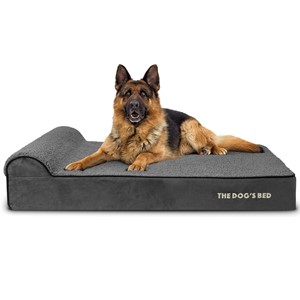
The Dogs Bed XL Grey Orthopedic Rectangle Bed
Price At Time of Publish $130.00 $185.00

KOPEKS Jumbo Orthopedic Rectangular Bed
Price At Time of Publish $130.00 $110.00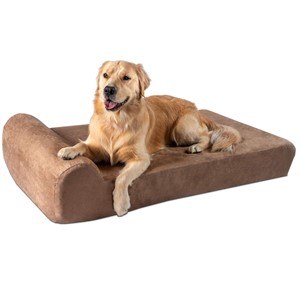
Big Barker XL Orthopedic Rectangle Bed
Price At Time of Publish $130.00 $240.00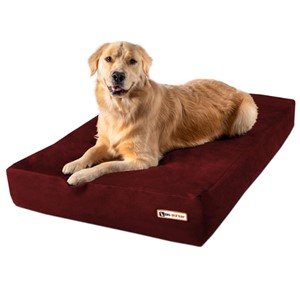
Big Barker XL Burgundy Orthopedic Rectangle Bed
Price At Time of Publish $130.00 $200.00

Serta XL Brown Orthopedic Rectangle Bed
Price At Time of Publish $130.00 $80.00
DogBed4Less XL Blue Orthopedic Rectangle Bed
Price At Time of Publish $130.00 $80.00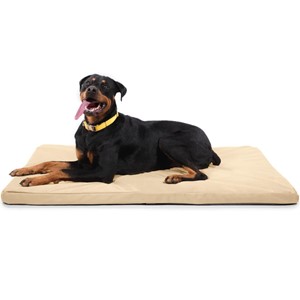
K9 Ballistics XL Sandstone Orthopedic Crate Pad
Price At Time of Publish $130.00 $159.00
Shop Bolster Dog Beds

Brindle XL Gray Orthopedic Bolster Bed
Price At Time of Publish $130.00 $79.00
Bedsure XL Blue Orthopedic Bolster Bed
Price At Time of Publish $130.00 $76.00
Bedsure XL Grey Orthopedic Bolster Bed
Price At Time of Publish $130.00 $60.00
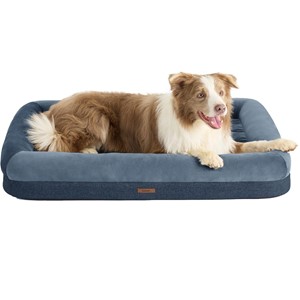
Lesure XL Navy Orthopedic Bolster Bed
Price At Time of Publish $130.00 $40.00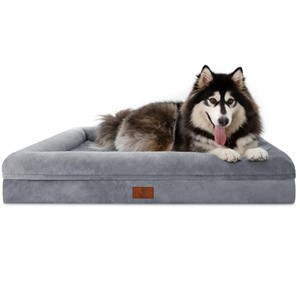
Yiruka XL Grey Orthopedic Bolster Bed
Price At Time of Publish $130.00 $55.00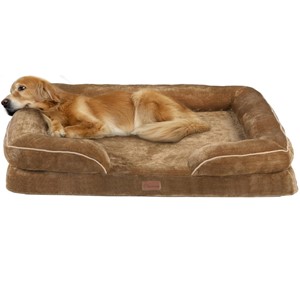
Yitahome XL Brown Orthopedic Bolster Bed
Price At Time of Publish $130.00 $37.00
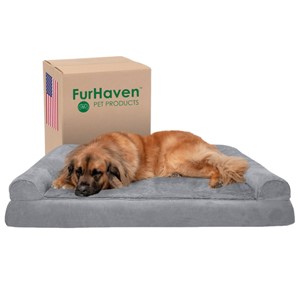
Furhaven XL Gray Orthopedic Bolster Bed
Price At Time of Publish $130.00 $130.00
PetFusion XL Grey Orthopedic Bolster Bed
Price At Time of Publish $130.00 $60.00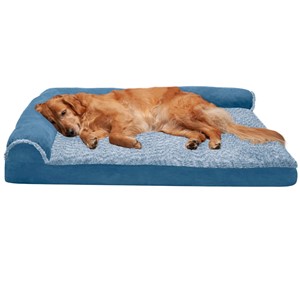
Furhaven Jumbo Blue Orthopedic Bolster Bed
Price At Time of Publish $130.00 $60.00
Shop Elevated Dog Beds
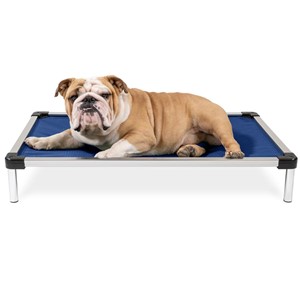
K9 Ballistics Chew Proof Elevated Small Bed
Price At Time of Publish $130.00 $129.00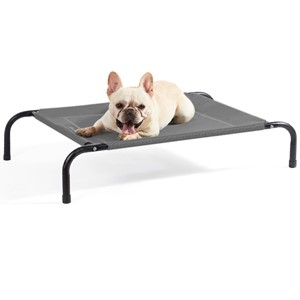
Bedsure Medium Elevated Dog Bed
Price At Time of Publish $130.00 $33.00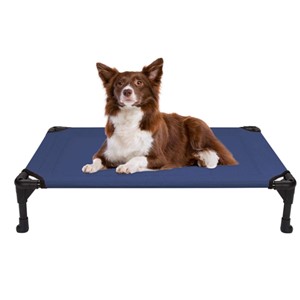
Veehoo Medium Elevated Dog Bed
Price At Time of Publish $130.00 $45.00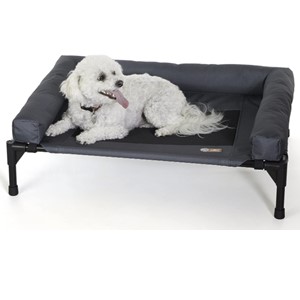
K&H Pet Products Elevated Bolster Dog Bed
Price At Time of Publish $130.00 $57.00
Kuranda Elevated Chew Proof Small Dog Bed
Price At Time of Publish $130.00 $134.00
Coolaroo Small Elevated Dog Bed
Price At Time of Publish $130.00 $21.00
Related Articles
Below are some other articles you may be interested in reading. Just select on the topic of interest to learn more about it.
- Best Healthy Dog Food Brands
- Christmas Presents for My Dog
- Crates for Dogs
- Critical Signs Your Dog Needs Help
- Dog Training Techniques
- How To Train a Puppy
- Positive Reinforcement for Dog Training
- Puppy Proofing Your House
- Training Dog with Treats
- Using Alexa for Dog Behaviors
Go back to the Dog Luxury Beds home page.

